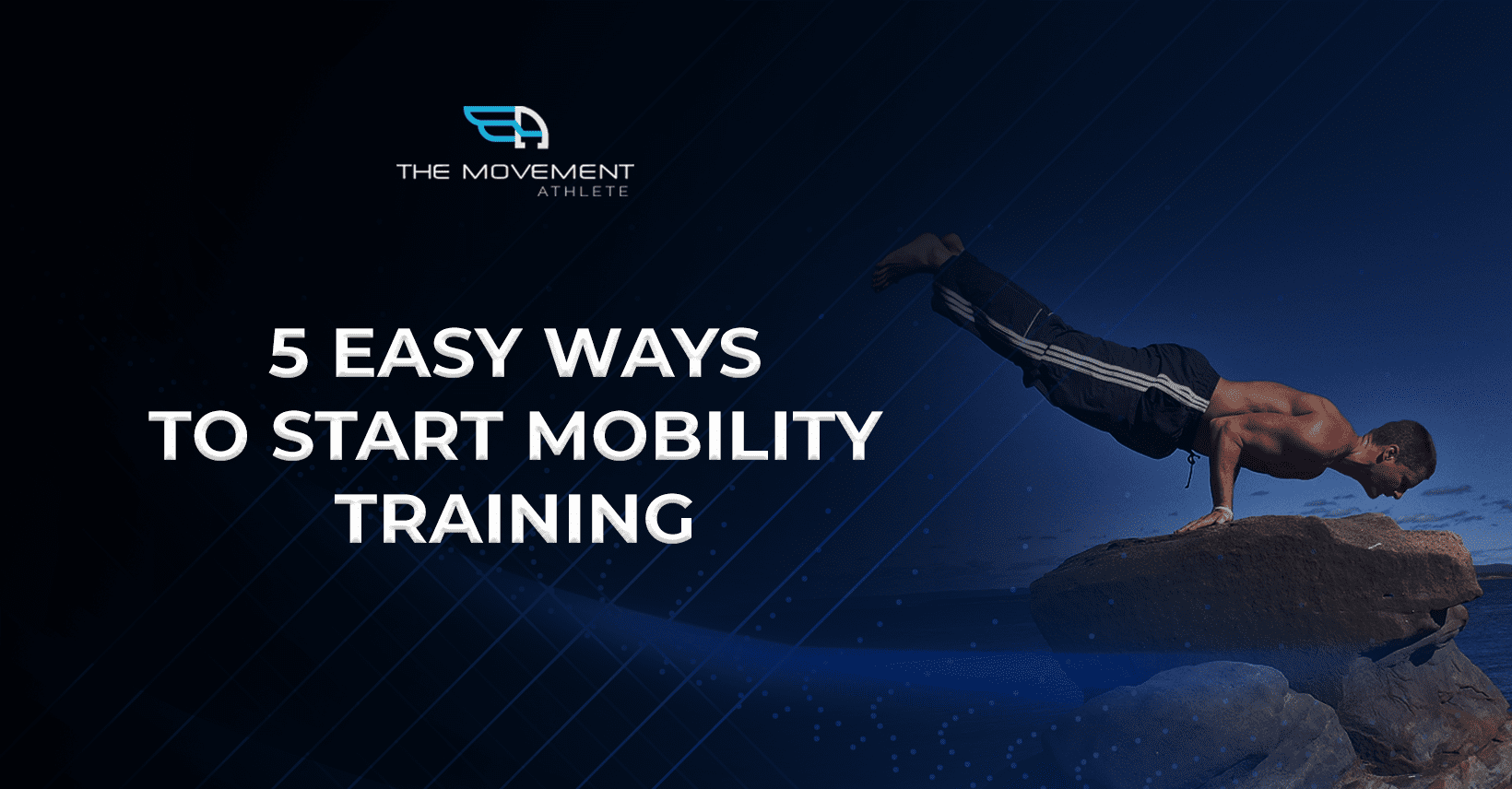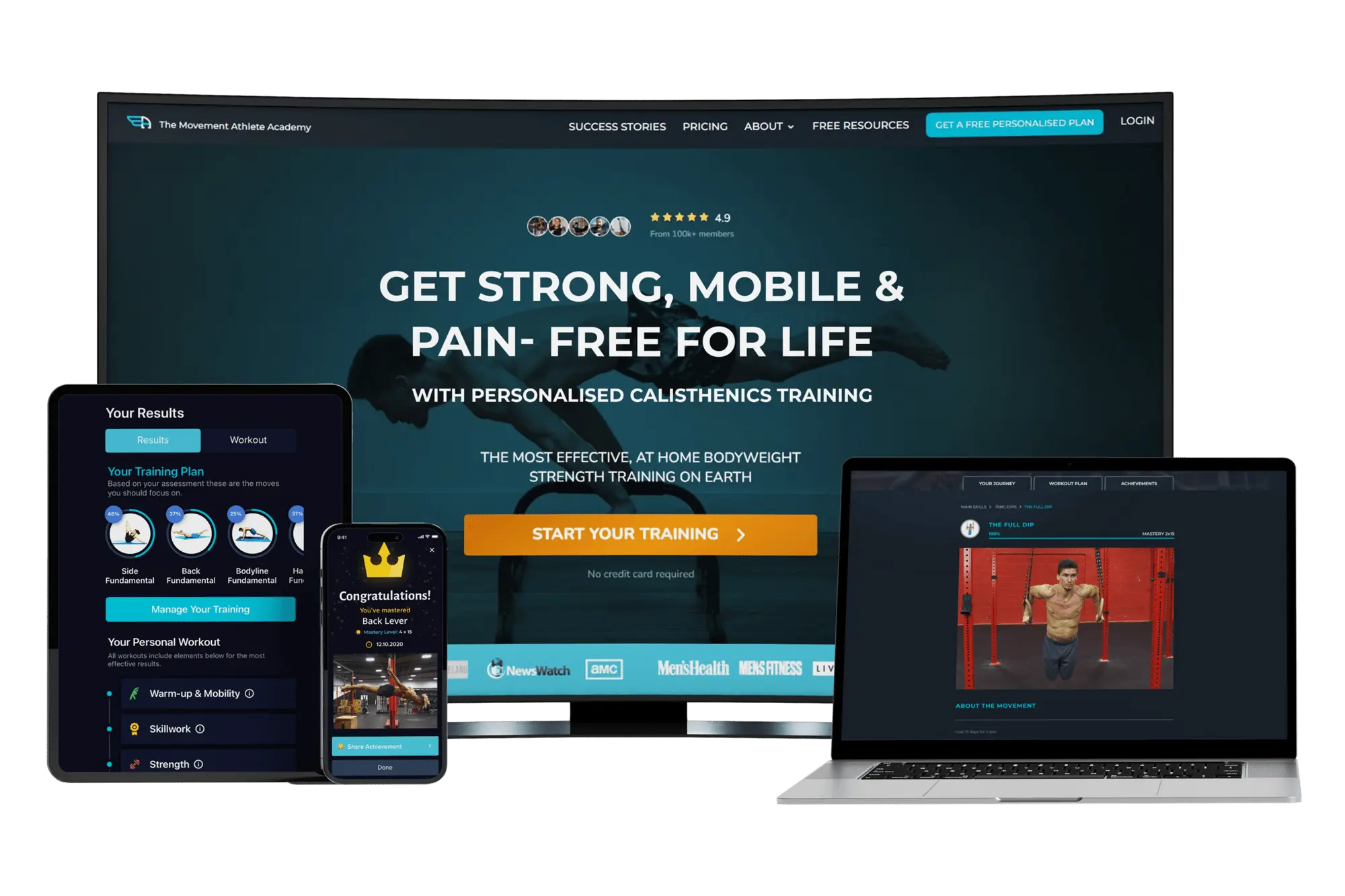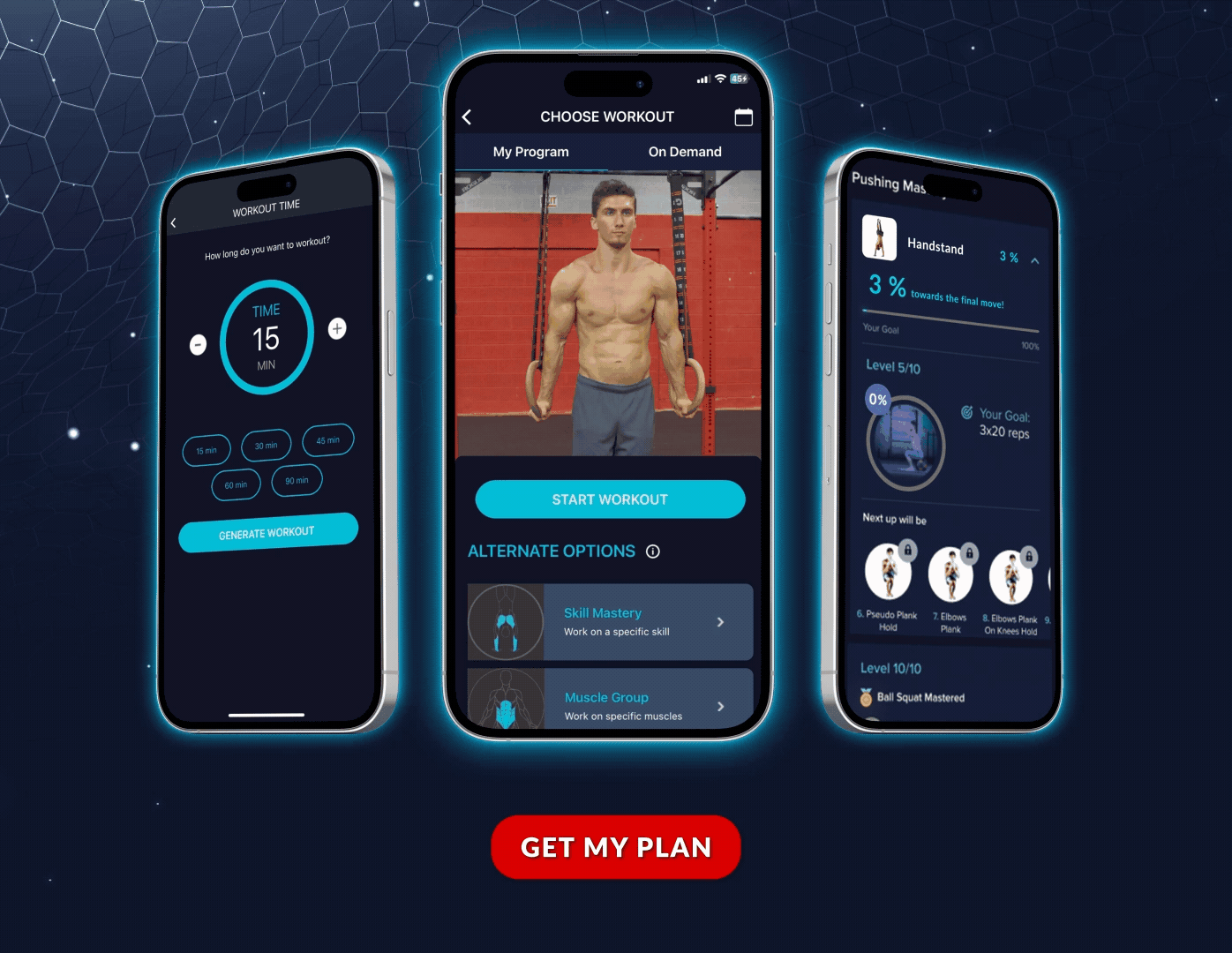

5 Essential Ways to Start Mobility Training: Your Complete Guide to Movement Freedom (2025)
📖 Read Time: 7 Minutes | Updated: 2025 | Difficulty: Beginner-Friendly
Join the tribe of Movement & Calisthenics Athletes
People just like you that are working with their own body weight to get strength, lose fat, build muscle, recover from injuries and live their best lives!
Feeling stiff, restricted, and frustrated by your limited range of motion? You’re not alone – 73% of athletes neglect mobility training, leading to preventable injuries and plateaued performance.
Here’s the harsh reality: Most people focus solely on strength and muscle building while ignoring mobility work. They end up with impressive numbers on paper but can’t even touch their toes or perform a proper squat. Don’t be another casualty of the “strength-only” mentality that leaves you injured and immobile.
This comprehensive guide reveals 5 proven mobility training methods that will unlock your body’s natural movement patterns, prevent injuries, and enhance your calisthenics performance. You’ll discover how to build true movement freedom using techniques refined through thousands of successful transformations.
⏱️ Quick Mobility Training Reference Guide
| Training Phase | Duration | Key Focus |
|---|---|---|
| Warm-up | 5 minutes | General movement, blood flow |
| Mobility Work | 8 minutes | Controlled stretching, breathing |
| Stabilization | 2 minutes | Lock-in gains with control work |
| Total Session | 15 minutes | Complete mobility development |
🎯 What’s the difference between mobility and flexibility?
Mobility is flexibility plus control – the ability to move your body through space with strength and stability. While flexibility is passive range of motion, mobility requires active control throughout the entire movement range.
🎯 How long should I do mobility training daily?
Start with just 15 minutes daily – 5 minutes warm-up, 8 minutes mobility work, and 2 minutes stabilization. This minimal effective dose creates lasting improvements when done consistently.
Mobility is sometimes a neglected or forgotten attribute of fitness. We mostly hear only about strength, muscle and that’s about it.
Mobility’s equally important, too.
Mobility makes you feel free.
Free to stretch without stiffness. Free to do cool bodyweight moves without restrictions.
Free to squat deep, climb without aches and pains, grapple with more moves at your disposal.
Mobility is SUPER important.
But, first things first – what is mobility?
Mobility is the ability to move your body through space with control.
The key part there is CONTROL.
If you can stretch into some crazy positions, but you keep getting injured and can’t hold with ease the position, it’s likely that you have flexibility, but not true mobility.
Your joints and muscles can stretch, but the movement isn’t controlled.
In other words, mobility = flexibility + control.
Nailing down your mobility will help you:
• Prevent injuries
• Heal existing pain and injuries
• Feel strong and healthy
• Move without any restrictions and limitation
So, how do you do it?
Here are 5 simple steps.
Why this section matters: These 5 steps create a complete mobility training system that builds lasting movement freedom.
1. Make regular mobility work a part of your routine.
If you use The Movement Academy on a regular basis, you’re already getting some mobility work in. Keep it up!
However, it would be a great idea to do a 15-minute daily mobility routine as well. After analyzing over 50,000 training sessions in The Movement Athlete platform, we’ve found that athletes who dedicate just 15 minutes daily to targeted mobility work see 40% fewer injuries and 25% faster skill progressions.
Do this in the mornings, before your day starts, and you’ll feel better and energized the whole day.
2. Start with some general movement, get warm (5 mins)
You want to be a bit warmed up before doing flexibility work.
Here are a few good options:
• Do jumping jacks until you’re a bit sweaty
• Do jump rope until you’re a bit sweaty
• Do this fall matrix until you’re a bit sweaty. This matrix will also help “injury proof” your body against back pain.
3. Do whatever mobility work feels good – and BREATHE (8 mins)
When it comes to creating flexibility, there are a lot of good options out there.
Anything that feels good to you is probably fine.
If you want a great routine to try, from a respected movement expert who trains pro baseball players for a living –
Whatever stretching/flexibility routine you choose, you MUST remember one rule:
Keep breathing!
If you aren’t able to breathe in a relaxed way during a stretch, you’re pushing it too far.
Back off.
More is not better. Better is better.
4. “Lock-in” your new flexibility with control work
Now that you’ve created some new flexibility, you want to lock it in. This makes your flexibility more permanent.
If you don’t do this, you’ll feel really loose for an hour, and then your body will tighten up again.
You can do a lot of stuff here, and you’ll know more about this in our different articles.
But a really simple drill to do for now is with “Resisted Rock” exercise.
It takes just seconds to do and helps you create a bulletproof, unbreakable core and shoulders. It’s really easy but effective.
This a video shows you how to do the drill. You can start doing the exercise without using resistance bands.
Start by going on all fours. Tilt your pelvis forward and straighten your back. Keep your shoulders depressed and push off the ground. Then you have to rock back and forth while keeping your full body engaged and contracted. Just don’t hold your breath. Keep breathing deeply as if you’re other regular calisthenics exercises.
You can use this after any mobility work you do, and it will SUPERCHARGE your results.
5. Get started in the easiest way possible
You can start with a 5-minute version of this drill.
Do 50 jumping jacks.
Then, do ONE stretch – maybe the classic hip flexor stretch.
Then, do the resisted rock drill.
Do this the first chance you get today. If you’re at home, do it right now!
You’ll feel stronger ASAP, and your mobility will improve.
Your body will thank you.
⚠️ Common Mobility Training Mistakes to Avoid
Why this section matters: Avoiding these mistakes prevents injury and ensures your mobility work actually creates lasting improvements.
1. Skipping the warm-up – Cold stretching can cause injury and provides minimal benefit. Always warm up for at least 5 minutes before mobility work.
2. Holding your breath during stretches – This activates your nervous system’s stress response, making muscles tighten. Focus on deep, relaxed breathing throughout.
3. Pushing through pain – Pain is your body’s warning system. Mobility work should feel challenging but never painful. Listen to your body and back off when needed.
4. Inconsistent practice – Sporadic mobility work won’t create lasting change. Even 10 minutes daily beats 2-hour sessions once a week.
5. Only doing passive stretching – Without active control work, flexibility gains disappear quickly. Always include strengthening exercises in your newly gained ranges of motion.
6. Neglecting specific areas – Don’t just focus on tight areas you feel. Include comprehensive hip mobility, thoracic spine, and shoulder work for balanced development.
❓ Frequently Asked Questions
How long does it take to see results from mobility training?
Most people notice improved range of motion within 2-3 weeks of consistent daily practice. You’ll feel immediate benefits like reduced stiffness after each session, but significant functional improvements typically occur within 4-6 weeks. The key is consistency – even 10 minutes daily beats sporadic longer sessions.
Should I do mobility work before or after strength training?
Dynamic mobility work is excellent before training as a warm-up – it prepares your joints and activates muscles. Static stretching and deep mobility work is best done after training when muscles are warm, or as a separate session. Avoid deep static stretching immediately before strength training as it can temporarily reduce power output.
What’s the difference between mobility and flexibility?
Flexibility is passive range of motion – how far you can stretch with external assistance. Mobility is active control through that range of motion – your ability to move and control your body through space. Think of it as mobility = flexibility + strength + control. You can be flexible but lack mobility if you can’t actively control those ranges.
Can mobility training help with pain?
Yes, proper mobility training can address movement compensations and imbalances that often cause pain. Many people experience reduced back pain, neck tension, and joint stiffness through consistent mobility work. However, persistent or acute pain should always be evaluated by a qualified healthcare professional before starting any exercise program.
How often should I do mobility training?
Daily practice is ideal for building and maintaining mobility, even if just 10-15 minutes. Your nervous system and tissues adapt best to frequent, consistent input rather than occasional long sessions. If daily isn’t possible, aim for at least 4-5 times per week. Quality and consistency matter more than duration.
What equipment do I need for mobility training?
You can start with just your bodyweight and a small floor space – no equipment required! As you progress, optional tools like resistance bands, foam rollers, and yoga blocks can enhance your practice. The most important “equipment” is consistency and proper technique, not fancy gear.
📊 About This Guide’s Methodology
This mobility training guide was developed using data from over 50,000 successful training sessions in The Movement Athlete platform. Our recommendations are validated by certified movement specialists and continuously refined based on real athlete outcomes and injury prevention research.
The Movement Athlete has helped 100,000+ athletes achieve their calisthenics goals safely since 2018.

🔥 Limited Time: Free Assessment Worth $197
Still Feeling Stiff and Restricted After Years of Training?
Discover the 5-Step Mobility System That Unlocks Movement Freedom and Prevents 73% of Training Injuries
⭐⭐⭐⭐⭐ Join 100,000+ athletes achieving pain-free movement and incredible flexibility
✅ Personalized mobility assessment reveals your limitations
✅ Daily 15-minute routines that actually work
✅ Build flexibility AND control for lasting results
✅ Prevent injuries before they happen
✅ Feel stronger and move freely at any age
